What Is Honeynut Squash And How Do You Best Cook It?
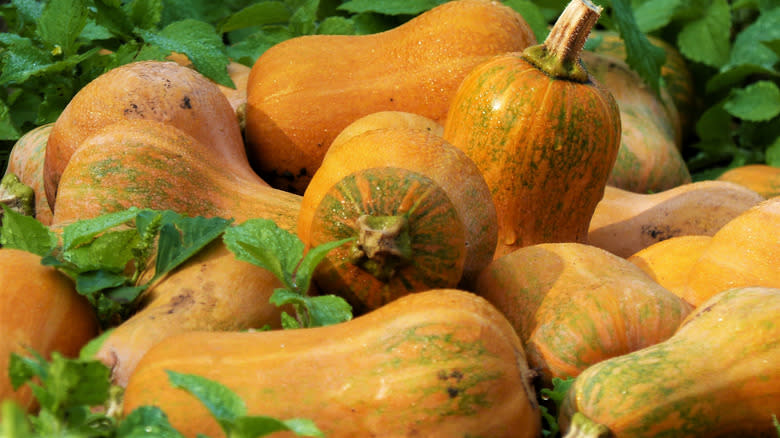
Between butternut, acorn, spaghetti, and kabocha, we're making the most of in-season squash during the fall. But if you've ever seen what look like mini butternut squash at the grocery store or farmers market, you may have come across a newer variety: honeynut squash. This version is a different type entirely than its larger bretheren, and it goes by a couple different names: its scientific name, Cucurbita moschata, and its nickname, winter squash.
Unlike the other squash mentioned, the honeynut variety was bred to be a better, tastier type than its predecessors. If you've never heard of it, that may be because it hasn't existed for very long. Honeynut squash made its public debut in 2011 and only started popping up in farmers markets a few years ago. But if you get your hands on one, there are a plethora of reasons to try out butternut squash's cuter cousin -- one of which being that it's simply easier to carry.
Read more: 17 Types Of Potatoes And When To Use Them
What Is Honeynut Squash?
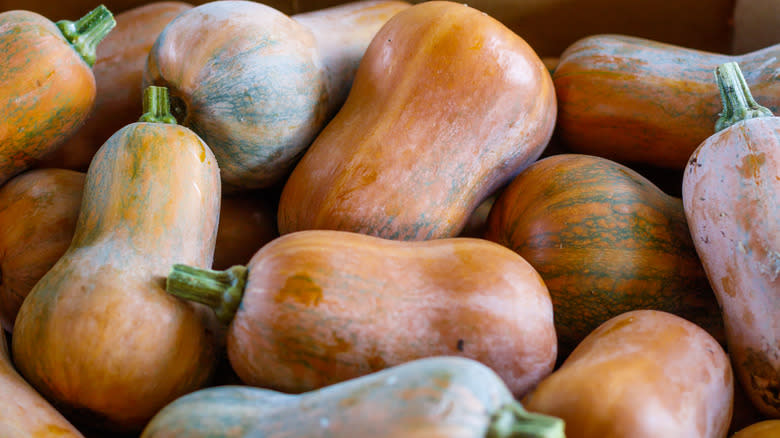
If you've ever lugged home a massive butternut squash from the farmers market, you may have wished for a version that could fit in the palm of your hand -- and the honeynut squash can do just that. Typically up to five inches long, these fruits look almost exactly like fun-sized butternut squash. They're a sunny orange color with green tips and thin skin, and you'll occasionally see green ribbons on the outside. If you cut one open, however, you'll find darker orange fruit and off-white-colored seeds. Honeynut squash are part of the Cucurbitaceae plant family, making them a close relative of pumpkins, melons, and cucumbers.
While we previously called honeynuts the brothers or cousins of butternut squash, they're technically their offspring. The fruits were bred to combine butternut and buttercup squash -- the latter of which is pumpkin-shaped but smaller than the real thing, and boasts a thick green skin. It's one of the sweeter varieties, which is a quality that it passed onto honeynut squash. The creation of honeynuts came about when Dan Barber, co-owner of New York restaurant Blue Hill, asked Cornell University professor Michael Mazourek to make him a new and improved butternut variety. About 30 years after Barber made his request, the new fruit was launched at the G9 Chef's Summit, a worldwide chef's convention.
Honeynut Vs. Butternut Squash
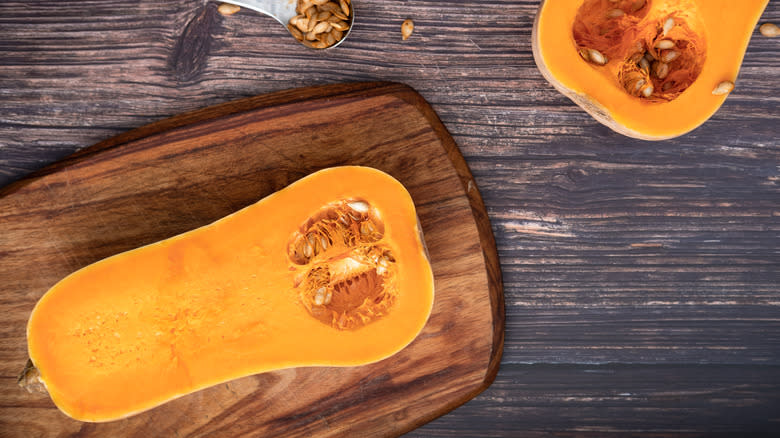
The most obvious difference between honeynut and butternut squash is the fruits' size. While we know the former can easily be held in one hand, the latter can grow up to 18 inches long and weigh up to five pounds. Other than that, their appearance is fairly similar. Both squash have an orange exterior, a green tip, and occasionally green ribbons throughout, along with orange flesh and pale seeds. Just like with honeynut, the butternut fruits have a thin skin, but the difference you can leave the skin on while roasting a honeynut squash and even eat it, whereas you would typically peel a butternut squash before cooking it.
You may be surprised to learn that just like honeynuts, butternuts are also a man-made squash variety. They were created in Massachusetts in the 1940s by Charles Leggett, who combined a gooseneck squash with other types to create a smooth, sweet new version. We know that honeynuts were bred to be a better version of butternuts, and here's what they have that their parents don't: The smaller squash are sweeter with a more concentrated flavor, along with a smooth flesh that differs from the bigger variety's stringier insides. And of course, butternut halves take much more time to roast than honeynuts due to their larger size.
What Does Honeynut Squash Taste Like?
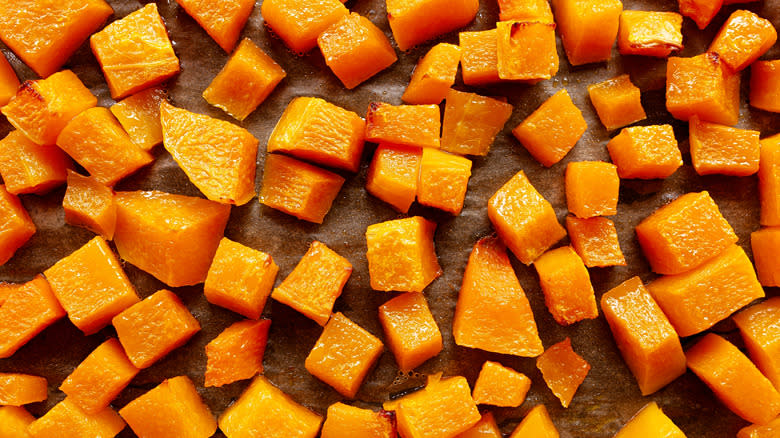
As we mentioned, honeynut squash has an intensely sweet flavor, which makes sense considering it was bred to be a tastier version of butternut squash. Specifically, Barber asked Mazourek to create a variety that was so sweet, you shouldn't have to add sugar to it. Think of all the flavor in a butternut squash, packed into a mini version of the fruit -- and minus a majority of the liquid, since honeynuts have a much lower water content than butternuts. The fruit's flesh is smooth and creamy, with notes of nuttiness, earthiness, and caramel that are amplified when roasted. As we know, the skins are so thin that many prefer to leave them on and eat them, and they can also develop a caramelized flavor once roasted.
Except for the aptly named sugar pie pumpkins, honeynut squash may be one of the sweetest varieties around, although the sugary taste isn't overwhelming because of the other flavors involved. But if you're looking for something a little more savory, opt for a kabocha or acorn squash. And if you want something stringier than the smooth texture of honeynut, go for a spaghetti squash.
How To Cook With Honeynut Squash
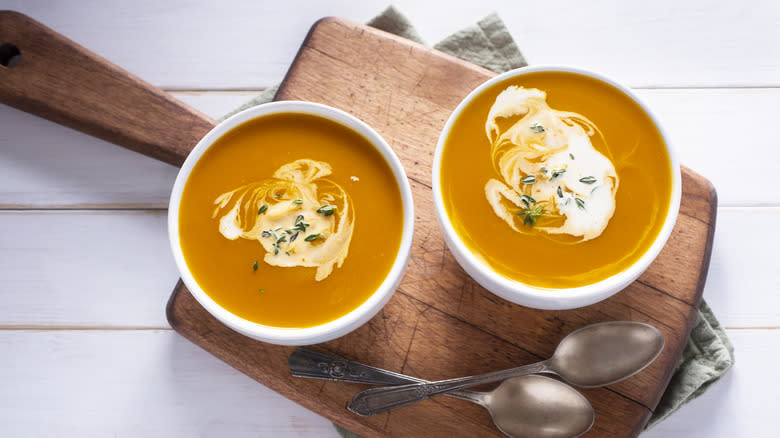
You can cook honeynut squash in a similar manner to butternut squash, taking into account the significant size difference. Luckily, due to their petite nature, honeynuts are much easier to cut in half than their parent fruits, and their seeds can easily be scooped out and roasted. But you should wash your squash before doing anything else since you likely will be eating the skin. You can roast them cut side up or down on a baking sheet at high heat so that the sugars caramelize, but it should only take half an hour at most in a 425-degree Fahrenheit oven until they're done. Seasonings that pair well with honeynuts include salt, pepper, garlic powder, paprika, rosemary, thyme, cinnamon, and nutmeg.
Once your caramelized squash halves emerge from the oven, you can slice them or stuff their centers with your favorite fillings, including ingredients like rice, beans, sausage, cheese, and veggies. You can also dice or mash the flesh, which will work perfectly in any recipe that calls for butternut squash (like a fall flatbread or salad), although you may want to buy more honeynuts than the original recipe lists. But if you want to take advantage of the fruits' extra sweetness, douse halves in brown sugar, cinnamon, and chopped pecans when they're done roasting.
Where To Buy Honeynut Squash

Luckily, honeynut squash has gained popularity in the past few years, so you may be able to find it at major grocery stores like Sprouts and Costco. Just like many other squash, it's in season during the fall months of September through November -- although thanks to its winter squash nickname, you may also find it in December. However, there's also a good chance you'll be able to track down the fruit at farmers markets during this time. And if you want to try growing your own at home, a variety of online retailers sell the seeds, including Walmart, Etsy, and Johnny's Seeds.
When selecting a honeynut squash from the bunch, look for one that's primarily orange with as little green as possible. Young honeynuts are entirely green, but they show that they're ready to be harvested by turning orange. A fruit that has green ribbons remaining can indicate that it hasn't fully matured. Also, check for taut skin that doesn't have any wrinkles and a firm texture with no softness.
Nutritional Information About Honeynut Squash
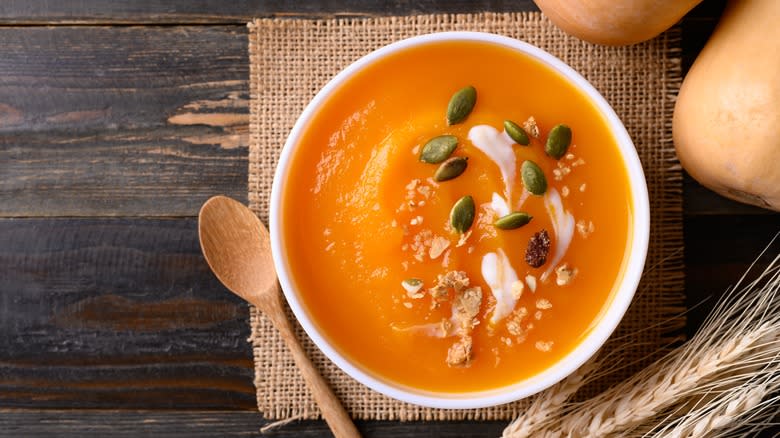
Despite honeynut squash being smaller than butternut, it actually contains three times as much beta-carotene as its parent fruit. The squash also boasts vitamin C, potassium, fiber, iron, and calcium, making it a highly nutritious food. According to WebMD, beta-carotene can help improve eye health and cognitive function, may help protect your skin against UV rays, and may help prevent cancer. It's a powerful antioxidant and one that our bodies convert into vitamin A when we ingest it. Also an antioxidant, the vitamin C in honeynut squash may help your immune system work more efficiently, your wounds heal faster, and your body to produce more collagen, per Healthline.
You may not want to overdo it with honeynut squash if you take beta-blockers or ACE inhibitors, according to Medical News Today, because they contain potassium and may increase the risk of hyperkalemia -- or too much potassium in your blood. In the same vein, those with kidney problems may want to eat honeynut squash in small amounts. And while it's unlikely you'll eat enough squash to consume too much beta-carotene (as delicious as honeynut may be), WebMD explains that doing so may cause your skin to glean a slightly yellow hue.
How To Store Honeynut Squash

Because honeynut squash are so small and have a thinner skin compared to other varieties, they won't last as long in your kitchen. In fact, this quality is what inspired Mazourek to develop a new type of squash after the honeynut called honeypatch, which is built to stay fresh for longer. If you haven't cut into your honeynut yet, keep it in a pantry or cabinet out of the sunlight, where it will be good for up to three months. These fruits like cool, dark places, but keep them out of the fridge, since the chilly air can alter their texture. After you cut into one and cook it, however, your squash should be good for a week in the fridge or three months in the freezer. If you slice into yours but don't have time to cook it just yet, you can also freeze the fruit for three months. To defrost it, simply keep it in an airtight container and place it in the fridge the night before you want to use it. Or if you need it even quicker, you can place a sealed plastic bag with your fruit in a bowl of cold water until it's soft.
As with any food, however, make sure your squash hasn't started to deteriorate before you cut into it. If you notice wrinkly skin, that means your fruit is drying out, so you may want to cook it immediately or chuck it.
Read the original article on Tasting Table.

